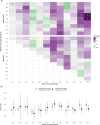Long-term drought and risk of infant mortality in Africa: A cross-sectional study
- PMID: 39888958
- PMCID: PMC11785314
- DOI: 10.1371/journal.pmed.1004516
Long-term drought and risk of infant mortality in Africa: A cross-sectional study
Abstract
Background: As extreme events such as drought and flood are projected to increase in frequency and intensity under climate change, there is still large missing evidence on how drought exposure potentially impacts mortality among young children. This study aimed to investigate the association between drought and risk of infant mortality in Africa, a region highly vulnerable to climate change that bears the heaviest share of the global burden.
Methods and findings: In this cross-sectional study, we obtained data on infant mortality in 34 African countries during 1992-2019 from the Demographic and Health Surveys program. We measured drought by the standardized precipitation evapotranspiration index at a timescale of 24 months and a spatial resolution of 10 × 10 km, which was further dichotomized into mild and severe drought. The association between drought exposure and infant mortality risk was estimated using Cox regression models allowing time-dependent covariates. We further examined whether the association varied for neonatal and post-neonatal mortality and whether there was a delayed association with drought exposure during pregnancy or infancy. The mean (standard deviation) number of months in which children experienced any drought during pregnancy and survival period (from birth through death before 1 year of age) was 4.6 (5.2) and 7.3 (7.4) among cases and non-cases, respectively. Compared to children who did not experience drought, we did not find evidence that any drought exposure was associated with an increased risk of infant mortality (hazard ratio [HR]: 1.02, 95% confidence interval [CI] [1.00, 1.04], p = 0.072). When stratified by drought severity, we found a statistically significant association with severe drought (HR: 1.04; 95% CI [1.01, 1.07], p = 0.015), but no significant association with mild drought (HR: 1.01; 95% CI [0.99, 1.03], p = 0.353), compared to non-exposure to any drought. However, when excluding drought exposure during pregnancy, the association with severe drought was found to be non-significant. In addition, an increased risk of neonatal mortality was associated with severe drought (HR: 1.05; 95% CI [1.01, 1.10], p = 0.019), but not with mild drought (HR: 0.99; 95% CI [0.96, 1.02], p = 0.657).
Conclusions: Exposure to long-term severe drought was associated with increased infant mortality risk in Africa. Our findings urge more effective adaptation measures and alleviation strategies against the adverse impact of drought on child health.
Copyright: © 2025 Wang et al. This is an open access article distributed under the terms of the Creative Commons Attribution License, which permits unrestricted use, distribution, and reproduction in any medium, provided the original author and source are credited.
Conflict of interest statement
The authors have declared that no competing interests exist.
Figures




Similar articles
-
Floods and Diarrhea Risk in Young Children in Low- and Middle-Income Countries.JAMA Pediatr. 2023 Nov 1;177(11):1206-1214. doi: 10.1001/jamapediatrics.2023.3964. JAMA Pediatr. 2023. PMID: 37782513 Free PMC article.
-
Birth spacing and child survival in rural Senegal.Int J Epidemiol. 1996 Oct;25(5):989-97. doi: 10.1093/ije/25.5.989. Int J Epidemiol. 1996. PMID: 8921485
-
Drought severity and all-cause mortality rates among adults in the United States: 1968-2014.Environ Health. 2020 May 18;19(1):52. doi: 10.1186/s12940-020-00597-8. Environ Health. 2020. PMID: 32423443 Free PMC article.
-
Malaria prevention in pregnancy, birthweight, and neonatal mortality: a meta-analysis of 32 national cross-sectional datasets in Africa.Lancet Infect Dis. 2012 Dec;12(12):942-9. doi: 10.1016/S1473-3099(12)70222-0. Epub 2012 Sep 18. Lancet Infect Dis. 2012. PMID: 22995852 Review.
-
The associations of birth intervals with small-for-gestational-age, preterm, and neonatal and infant mortality: a meta-analysis.BMC Public Health. 2013;13 Suppl 3(Suppl 3):S3. doi: 10.1186/1471-2458-13-S3-S3. Epub 2013 Sep 17. BMC Public Health. 2013. PMID: 24564484 Free PMC article. Review.
References
-
- World Health Organization. Indicators [cited 2023 Aug 15]. Available from: https://www.who.int/data/maternal-newborn-child-adolescent-ageing/indica...)
-
- Sharrow D, Hug L, You D, Alkema L, Black R, Cousens S, et al.. Global, regional, and national trends in under-5 mortality between 1990 and 2019 with scenario-based projections until 2030: a systematic analysis by the UN Inter-agency Group for Child Mortality Estimation. Lancet Glob Health. 2022;10(2):e195–e206. doi: 10.1016/S2214-109X(21)00515-5 ; PMCID: PMC8789561 - DOI - PMC - PubMed
-
- He G, Perloff JM. Surface water quality and infant mortality in China. Econ Dev Cul Change. 2016;65(1):119–39. doi: 10.1086/687603 - DOI
MeSH terms
Grants and funding
LinkOut - more resources
Full Text Sources
Research Materials

